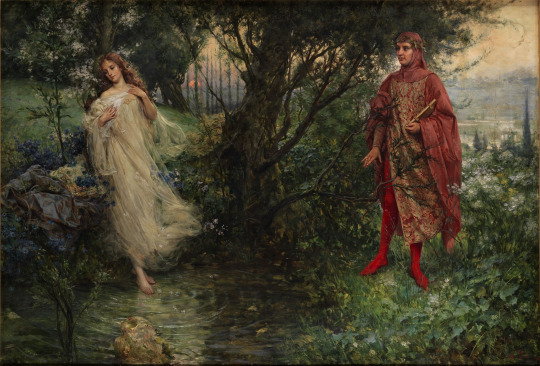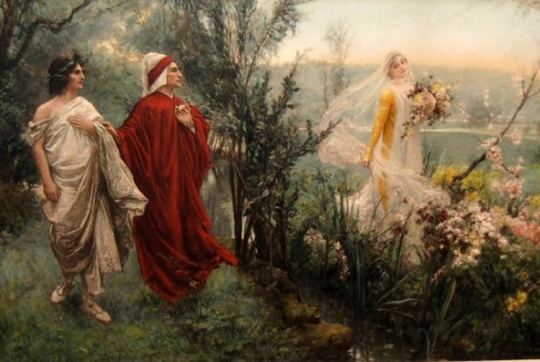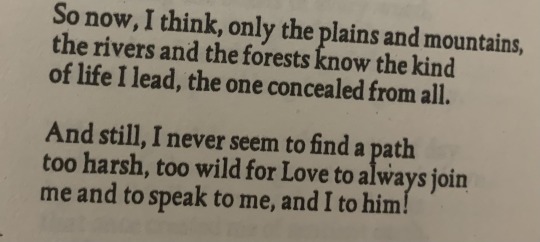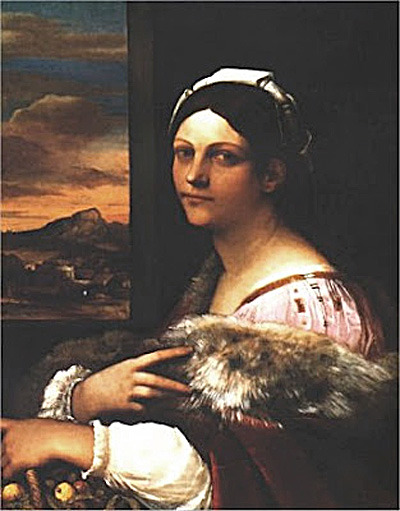#Canzoniere
Explore tagged Tumblr posts
Text

...OK. We may have a small art history mystery here. Bear with me, I'm probably full of shit, BUT. So: Neapolitan artist Salvatore Postiglione. This painting is attributed to him, and identified on Wikimedia Commons (referencing a German auction house that apparently listed this painting a while ago) as Dante and Beatrice. The problem is, I am convinced that's actually Petrarch and Laura. This guy looks nothing like the traditional image of Dante, which I wouldn't have an issue with except for two things: 1. He DOES look a lot like several existing portraits of Petrarca. A round-ish and somewhat boyish face, large eyes, that very particular red hood with the round neckline and laurel crown over it, and - you know it - fabulous, glamorous red hose. (I am not seriously presuming to use the hose as an identifying piece of iconography, I just find it delightful how often he shows up in them. Slay, darling.) 2. There is another painting attributed to Postiglione of Dante, Virgil and Matelda, in which Dante looks like our standard-issue Dante, with the aquiline nose and angular face, the red and white cap, and everything we're used to seeing him in. (Hiiiiii Virgilio you look gorgeous too, whatever you're doing with your hair keep it up.)

Now back to the original painting, the one identified as Dante and Beatrice. What's with the setting? I could see that woman being Matelda, in an idyllic Eden setting from the end of Purgatorio, except I'd wonder where Virgilio is. But Beatrice? She appears in Canto 30 surrounded by angels, and addresses Dante directly. It doesn't fit. This is an apparently secular scene. Our lady has already taken off her cloak and seems to be about to strip the rest off to go for a swim, with our red-stockinged poet watching her from an extremely inconspicuous hiding spot behind a single tree branch. I submit: no. 126 from the Rerum vulgarium fragmenta, one of the most famous poems in the collection. It begins: Chiare, fresche et dolci acque, ove le belle membra pose colei che sola a me par donna; gentil ramo ove piacque (con sospir’ mi rimembra) a lei di fare al bel fiancho colonna. Clear and cool sweet waters where the only woman who seemed a woman to me rested her beautiful limbs; the slender branch she liked so much (I sigh when I remember it) stood like a column by her lovely side. There is a rather prominently depicted slender sapling right at the woman's side in the painting, and as far as I can tell, it appears to be a laurel. A later verse continues: Da’ be’ rami scendea (dolce ne la memoria) una pioggia di fior’ sovra ’l suo grembo... From those beautiful branches (the memory is sweet) a rain of flowers fell into her lap... Also present in this painting: flowers and petals showering down around this "Beatrice", who is...actually Laura. How did this get misidentified? Does anybody know where this painting actually is (i.e., is it in a museum or a private collection?) It seems to be in a great big loop of Wikimedia referring back to itself, and other sites referring back to Wikimedia. Am I full of shit? Is this a scene in the Vita Nuova that I've totally blanked on? Am I just seeing Petrarca in the clouds and the coffee stains at this point?
#francesco petrarca#dante alighieri#salvatore postiglione#art history#art mystery#divina commedia#canzoniere#justice for laura
30 notes
·
View notes
Text




dal cor l'anima stanca si scompagna
#foto#fotografia#photo#scatti#photography#lettura#petrarca#canzoniere#warm light#warm#warmcore#aesthetic vibes#soft aesthetic#aesthetic#light#light academia#lightroom#room
122 notes
·
View notes
Text
AHHHHHH THANK YOU FOR RELEASING A SEQUEL SERIES ABOUT CESARE, FUYUMI SORYO SENSEI!!! 😭😭😭😭😭😭😭

#oh I miss this kind of drawing style and historical setting from her so much!!!!! ��😭😭#canzoniere#cesare il creatore che ha distrutto#Fuyumi Soryo
5 notes
·
View notes
Text
What a miracle she is, when she sits among the grasses like a flower,
#160 from The Complete Canzoniere by Petrarch
19 notes
·
View notes
Text




Regenerklärung (bolische Übersetzung)
1.
Alles preist, alles liest, alles rächt: um das mitzumachen,
beweis', bewitz und streichl' das Wetter.
Liebe, gib' noch einmal Dein himmlisches Schiffen.
Gleiche den Nächtigen, sie warten in der Stadt.
2.
Es war mein Rechner: herzlich beschränkt.
Ich sag's nur. Mit Augen die Augen verteidigen, das will ich.
Der Motor bröckelt ohnehin, es geht vorbei.
Ich trag' allerdings Schafswolle, darin blitze ich gut.
3.
Nun, vom ersten Tanz an lässt man tanzen,
so flutet der Rausch und der Spaß.
Auf Keksen können wir immer noch gehen.
4.
Bauch an Bauch, auf dem Hügel müde,
verschlafen, verschleiert, gedeckt.
Meine Augen verschlingen alles, noch deinen Po, immer.
#ferrara#Per fare una leggiadra sua vendetta#recht und regen#petrarca#francesco petrarca#canzoniere#bolische übersetzung
2 notes
·
View notes
Text

Petrarch, Selections from the Canzoniere
16 notes
·
View notes
Text

Francesco Petrarca - Il Canzoniere
13 notes
·
View notes
Text
“ «Ben altro è il cantare la Luna, che il mettervi il piede sopra come si è fatto il 20 luglio del 1969» scriveva un illustre fisico, Giorgio Salvini, inteso a mostrare la supremazia del fare e della tecnica sul sognare della poesia. Gli rispondeva un poeta, Giorgio Caproni: «altro è il cantare Laura, regalandoci per tutto frutto il Canzoniere, e ben altro è l’essere riusciti a conquistarla e ad andarci a letto»*, e sottolineava come i tecnici abbiano spesso una concezione distorta della poesia. Come se il poeta fosse il distratto perdigiorno che di notte canta la luna e le stelle... Ma anche se cosí fosse, che male c’è? Anzi, non c’è che bene, perché occorre con Caproni continuare a chiederci se conta di piú la luna sulla quale l’uomo ha messo piede con una navicella metallica, o conta la luna nella mente e nel cuore dell’uomo. Osservava George Steiner (seppur con qualche punta di estremismo) che [...] pur possedendo un fascino inesauribile e una bellezza frequente, soltanto di rado le scienze naturali e matematiche hanno un interesse definitivo. Esse cioè hanno aggiunto poco alla nostra conoscenza o al dominio delle possibilità umane; c’è maggior penetrazione del problema dell’uomo (e lo si può dimostrare) in Omero, in Shakespeare o in Dostoevskij, che in tutta quanta la neurologia o la statistica. Nessuna scoperta della genetica eguaglia o supera ciò che Proust sapeva del fascino o del fardello della discendenza; ogni volta che Otello ci ricorda la ruggine di rugiada sullo stelo lucente abbiamo un’esperienza maggiore della realtà sensuale e transeunte in cui deve trascorrere la nostra vita di quella che la fisica ha il compito o l’ambizione di comunicare. Nessuna sociometria dei moventi o delle tattiche politiche è piú importante di Stendhal**. “
* G. CAPRONI, Poesia e scienza: si può ancora cantare la Luna, in «Tuttolibri», 6 giugno 1987.
**G. STEINER, Linguaggio e silenzio. Saggi sul linguaggio, la letteratura e l’inumano [1958], Garzanti, Milano 2001, pp. 18-19.
---------
Gian Luigi Beccaria, In contrattempo. Un elogio della lentezza, Einaudi (collana Vele), 2022. [Libro elettronico]
#letture#leggere#citazioni#saggistica#scritti saggistici#libri#Gian Luigi Beccaria#In contrattempo.#George Steiner#fisica#elogio della lentezza#tecnica#poesia#Canzoniere#umanità#sbarco sulla luna#Giorgio Caproni#scienze naturali#Stendhal#Giorgio Salvini#Omero#Otello#Marcel Proust#conoscenza#intellettuali del XX secolo#William Shakespeare#arte#artisti#Fëdor Dostoevskij#questione delle due culture
16 notes
·
View notes
Text

Francesco Petrarca, Canzoniere, Sonetto XXXV
2 notes
·
View notes
Text
Leggi “A mia moglie” di Umberto Saba, un inno all’amore coniugale che celebra la donna reale. Recensione e biografia completa del poeta. Scopri di più su Alessandria today.
#Alessandria today#Amore Autentico#amore coniugale#amore e natura#amore quotidiano#amore reale#amore semplice#Canzoniere#Google News#Immagini Quotidiane#italianewsmedia.com#Lava#Lina Wölfler#Pier Carlo#poesia autobiografica#poesia che racconta#poesia concreta#poesia coniugale#poesia d’amore#Poesia del Novecento#poesia e donna#poesia e famiglia#poesia e matrimonio#poesia e memoria#poesia e vita#poesia ebraica#poesia esistenziale#poesia italiana#poesia italiana del 900#poesia minimalista
0 notes
Text
…i’m sorry for all the Petrarcaposting but you guys?? A 1470 edition of the Canzoniere illuminated by Antonio Grifo includes an illustration of the poor bastard metamorphosing Ovid-style into a laurel tree like Daphne pursued by Apollo?

#the gender swapping! the laura/lauro double meanings! the paganism! i am obsessed with this!#francesco petrarca#canzoniere#renaissance art
50 notes
·
View notes
Text

Rimanti in questi boschi.
#petrarca#canzoniere#foto#fotografia#photo#scatti#photography#lettura#foto mie#nature photography#travel photography#france#cottage garden#cottage#cottage aesthetic#cottage vibes#cottagecore#forest cottage#cozy cottage#windows#english garden#garden#garden aesthetic#gardencore#nature#nature aesthetic#naturecore
45 notes
·
View notes
Text
Fugit irreparabile tempus
0 notes
Text
N.E. 02/2024 - "La religiosità spirituale nelle opere delle poete lucane: da Isabella Morra ad Anna Santoliquido", saggio di Francesca Amendola
L’opera di un poeta è fusione totale tra parole e immagine, che origina quello che Bachelard chiama retentissement, ossia la capacità della poesia di creare una sorta di “vicinanza” tra poeta e lettore, che mette in moto l’attività di comprensione e interpretazione. Petrarca scriveva che «la poesia, in quanto vera poesia, è sempre sacra scrittura» poiché nasce da una commistione tra ispirazione…

View On WordPress
#Amalia Marmo#Anna Santoliquido#Antonia Caracciolo#Arcadia#Aurora Sanseverino#canzoniere#Cristo#critica#dolore#fede#Forenza#Francesca Amendola#Giuliana Brescia#inquietudine#Isabella Morra#Laura Battista#letteratura#Lorenza Colicigno#Lucania#Lucinda Coritesia#Matera#N.E. 02/2024#pace#passione#poete#politica#profetessa#religione#Rivista Nuova Euterpe#Rosalba Griesi
0 notes
Text


Can. 6
doch, bar am tor verkehrt die welt
an und für sich fügt und dreht sich immer was
noch durch die liebe ist der fall/ man labert leicht
im sausen scheint‘s/ man sollte langsam reden
Die Einladung traf auch ins Herz,
kleine Pupillen sehns weniger.
Was soll man sonst noch singen? Erst O nahm ein zum Tanz.
Glotzend lässt die Liebe auf Bistrostühlen sitzen.
Was will man sich nachher beschweren?
the mission is to miss
Bis zum Tod soll man dabei, soll durchweg Tor am Tor sein.
Erstmal ist ans Meer zu kommen, eher an die Brandung,
die Äpfel können warten. Andere zählen
Die kramen ihre Gefälligkeiten, wir lassen das.
1 note
·
View note
Text

Petrarch, Selections from the Canzoniere
19 notes
·
View notes